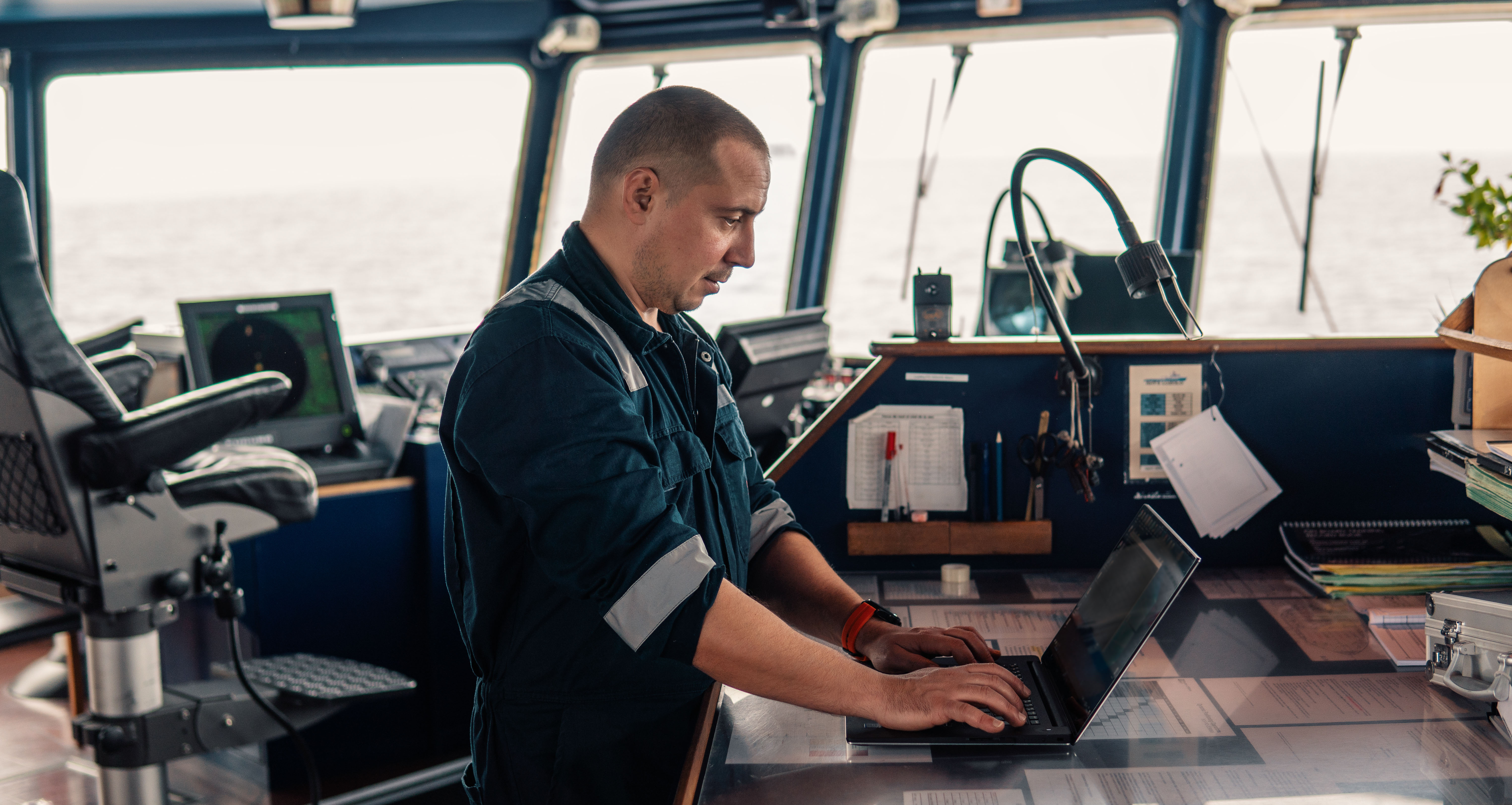Maritime Cybersecurity: Safeguarding the Digital Seas

Wilhelmsen insights
|
Wilhelmsen Ship Management
Maritime cybersecurity is about protecting ships, ports, and maritime infrastructure from digital threats that might lead to operational breakdowns, safety incidents, or environmental disasters. In practice, it means defending both on-board and shore-based networks from cyber-attacks, data breaches, malware, and other malicious activity.
According to the United Nations Conference on Trade and Development (UNCTAD), over 80% of global trade by volume is carried by sea, making it essential to keep these vital routes secure and disruption-free (source).
Modern shipping is more connected than ever, with systems that boost speed, coordination, and efficiency. But this connectivity also opens vulnerabilities. A single cyber incident could halt a vessel, disrupt logistics, or cause environmental harm. This article explores the key challenges in maritime cybersecurity, common threats, and best practices adopted today.
Common Cyber Threats in the Maritime Sector
Cyber threats in the maritime industry are becoming increasingly frequent and sophisticated, turning digital piracy into a serious risk for global shipping operations. According to the U.S. Coast Guard’s cybersecurity guidance, the most common types of cyber-attacks include:
- Phishing emails – Deceptive messages to trick crew members or staff into revealing credentials.
- Ransomware – Malware that locks critical systems or encrypts data, demanding payment for restoration.
- Malware and viruses – Software that disrupts navigation, communication, or other onboard systems.
These attacks don’t always target the ship directly. Hackers often exploit social engineering tactics or infiltrate shore-based systems such as suppliers, ports, or logistics networks to gain access to onboard systems (source).
A stark example occurred in 2023, when the LockBit ransomware group launched a cyber-attack on the Port of Lisbon, paralyzing operations for four days. The attackers demanded a $1.5 million ransom, highlighting how a single cyber-attack can cripple critical maritime infrastructure (source).
Such incidents can lead to failures in navigation systems, costly delays at ports, and disruptions in global trade—making cybersecurity a top priority for the maritime sector.
Why Maritime Cybersecurity Is Uniquely Challenging
The maritime environment introduces unique complexities:
- IT / OT convergence: Ships and ports combine IT (administrative) systems with OT (operational technology) — e.g., navigation, engine, cargo control. A breach in one domain can cascade into another.
- Connectivity constraints: At sea, connectivity is intermittent. Patching or continuous monitoring can be difficult.
- Legacy systems: Many vessels still run on older software or hardware that’s hard to update or secure.
- Human factor: Crew members may lack cybersecurity training, and inadvertent mistakes — e.g., using USB drives, weak passwords — can open doors for attackers. The IMO increasingly emphasizes that crew awareness and procedural discipline are just as important as technical defences (source).
Best Practices and Risk Management
Effective maritime cybersecurity relies on understanding and managing risks before they escalate into serious incidents. The following practices can help protect both shipboard and shore-based operations from evolving cyber threats.
Conduct Cyber Risk Assessments
Cyber risk assessments identify weaknesses and evaluate the potential impact of different types of threats. Assessments should cover onboard and shoreside systems such as navigational aids, cargo control, and crew-to-crew communications. Tools like vulnerability scanners, penetration testing, and maritime-specific compliance checklists are commonly used (source).
Segment IT and OT Networks
Separating IT and OT networks reduces cyber risks by preventing a breach in administrative systems from affecting operational technology like engine control. This physical or logical separation limits malware spread and strengthens incident containment.
Enforce Strong Access Controls
Implementing robust access controls — including password management, multi-factor authentication, and role-based permissions — is essential. Passwords should be unique, regularly updated, and never reused across devices. Multi-factor authentication ensures that stolen credentials alone cannot grant access, while role-based controls limit permissions to job-specific needs.
Establish Cybersecurity Policies and User Guidelines
Clear policies help standardise safe digital behaviour across both shipboard and shore-based personnel. These should include acceptable-use guidelines covering email, internet access, and removable media; password requirements that define complexity, rotation frequency, and sharing restrictions; and procedures for reporting suspicious activity. Consistent enforcement and regular reviews help maintain strong security discipline across the organisation.
Keep Systems Updated and Patched
Outdated systems are prime targets for attackers. In maritime operations, limited connectivity and tight schedules can make updates challenging, but scheduling them during low-activity periods and using verified backups helps avoid disruptions.
Develop an Incident Response Plan
A well-defined incident response plan ensures crews know exactly what to do during a cyber incident. Offline playbooks are vital in case digital systems are compromised. Drills should involve both shipboard and shore teams to test communications, decision-making, and recovery procedures.
Vet Third-Party Vendors
The maritime supply chain involves contractors, service providers, and equipment suppliers — all of which can introduce cyber risks. Careful vendor screening, including security questionnaires and contractual requirements, helps reduce exposure.
Train and Build a Cyber-Aware Crew
Human error remains one of the most common causes of security breaches. Training should cover threat recognition, safe communication practices, and secure equipment handling. Regular refresher courses ensure crews stay updated on emerging threats.
For further guidance, the European Union Agency for Cybersecurity (ENISA) provides comprehensive best practices for the maritime sector (source).
Compliance and Regulatory Landscape in Maritime Cybersecurity
The shipping sector is becoming increasingly regulated in terms of cybersecurity practices and policies. The International Maritime Organization (IMO) recognises cybersecurity as part of operational safety and, through Resolution MSC.428(98), encourages shipping companies to integrate cyber risk management into their existing Safety Management Systems (SMS) in accordance with the ISM Code. (source).
The NIS 2 Directive, which applies to most maritime operators across the European Union, focuses on prompt incident reporting, effective risk measures, and ensuring operational continuity (source).
To address security at the design stage, certain classification societies offer cybersecurity class notations for new vessels (source). These notations help operators meet regulatory requirements and satisfy insurance conditions.
Building on industry best practices, Wilhelmsen Ahrenkiel Ship Management, the container vessel management arm of Wilhelmsen Ship Management, has achieved ISO/IEC 27001 certification. This is an internationally recognised standard for managing and protecting an organization’s information assets. Meanwhile, Wilhelmsen Ship Management is currently in the process of obtaining it.
The maritime industry’s reliance on digital systems makes proactive cybersecurity a fundamental requirement for safe and resilient operations. As cyber threats evolve, protecting vessels, ports, and supply chains calls for a framework-driven approach that aligns with recognised standards.
By adopting the NIST Cybersecurity Framework, maintaining compliance with the NIS2 Directive, and applying cybersecurity class notation for newbuildings, maritime operators can strengthen both technological and procedural safeguards.
Through consistent application of these recognised frameworks and certifications, the industry can help ensure global trade routes remain secure, efficient, and dependable in an increasingly connected world.
